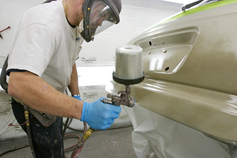 Smokestacks are only the most visible sources of air
pollution. In fact, less than a third of emissions
actually comes from such permitted sources. The
majority of air pollutants come from smaller, unregulated sources, such as
vehicles and wood burning and some types of small businesses.
Last year, the MPCA provided small
business grants to reduce air emissions called volatile organic compounds
(VOCs). VOCs are typically found in solvents used in printing, metal finishing,
painting, and other industrial processes. The fumes you smell while filling your car with gas, or the solvent
smell in an auto body shop are from VOCs. When
released into the air, VOCs combine with small particles to form harmful smog.They can also affect the health of a business’ employees and customers,
and that of the surrounding community.
So far, 13 small businesses in
Minnesota have received more than $500,000 to reduce VOCs. Together, these projects will eliminate almost seven
tons of VOC emissions every year,
equal to more than 13,000 cans of spray paint.
“The challenges we face with air
quality today are mainly from the smaller but numerous sources all around us,”
said MPCA Commissioner John Linc Stine. “They form the biggest part of our air
pollution and are largely unregulated, so voluntary actions are an important
part of the solution. We’re glad to help get things rolling.”
This grant project is part of a larger
statewide partnership known as Clean Air Minnesota,
which, in total, has reduced VOCs by more than 68 tons
per year, equivalent to about 136,000 cans of spray paint. Visit the MPCA VOC reduction page for more information, including a full list of grant recipients.
Be sure to watch the VOC
grant video, featuring Oscar’s
Auto Body. Check out stories from three MPCA small business
grant recipients below.
Dan
Loock’s Automotive – Redwood Falls
Dan Loock’s
Automotive used a $6,000 grant to buy a solvent recycler and a new water-based
parts washer. Both devices reduce the businesses chemical usage, and the
solvent recycler allows chemical solvents to be reused, rather than disposed of
after one use. The recycling process makes the solvent much less toxic and less
harsh on exposed skin, according to Loock. “When you are working with conventional
solvents, it is hard on the hands,” he said. “They get dried out fast,
especially in the winter.”
Loock is confident the
new equipment will be better for his business. “I was skeptical at first,” he said “after all, the products we’d been using worked.” But he’s sold on the new products.
And the MPCA grant
was key to making the changes. “These pieces of equipment are not cheap,” Loock
said. “Having the state help pay means getting something that would not have
been in my budget.”
Together
these changes have saved the company $3,550 per year, resulting in a 4 four
month payback period. Even without the grant, the investment would have been
recouped in just two years, making process conversion an attractive choice for many
businesses. Dan Loock’s Automotive reduced its overall VOC emissions by 736 pounds
per year, exceeding initial estimates.
Rupp’s Unique Auto Body – Elbow Lake
Rupp’s Unique Auto Body paint and
repair shop switched from a solvent-based to a water-based paint system.
Manager Thomas Rupp said they have been using the system for several months now
and it is totally different than the old system.
“It smells much better, unlike the solvents we’ve been using, which can give
you a headache. Another advantage we see is that it dries faster. With
everyone wanting things faster and faster today, that’s big for us.” Rupp
estimates the new system will reduce their VOC emissions by more than 40%.
Owner Ryan Rupp said there was a
bit of a learning curve, but now that the water-based system is in place, he
likes it much better than the old system. “Not only does it smell better and
the paint dries almost instantly, it actually does a better job and looks
better than oil-based paint.”
Valley Craft – Lake City
Valley Craft, a manufacturer of
material-handling equipment, received a $100,000 grant toward its $150,000
conversion to a powder-coating system from a liquid paint system. Unlike liquid
paint, powder coating doesn’t contain solvents and releases little or no VOCs. The
company expects to reduce VOCs by more than three tons per year. Valley Craft
now confines its use of liquid paint to objects that can’t withstand the 370-degree
powder-coating oven. Operations Manager Tom Balow said the company has used
just one gallon of wet paint in the last two months.
The upgrade made environmental as well as
business sense. Less wet paint means less hazardous waste and less regulation
from the MPCA. “Powder coating is a lot easier to apply,” Balow said. “It’s a
lot easier to train employees to use. Lastly, it’s a higher quality, more
durable finish. And unlike wet paint, the powder finish won’t just give under
pressure from a fastener.
“It’s been great to work with Balow and Valley
Craft,” states Eric David, nonpoint air lead at the MPCA, “The state is happy
to help a great small business ... that wants to do the right thing by
improving the health of its employees and reducing its air pollution.
|